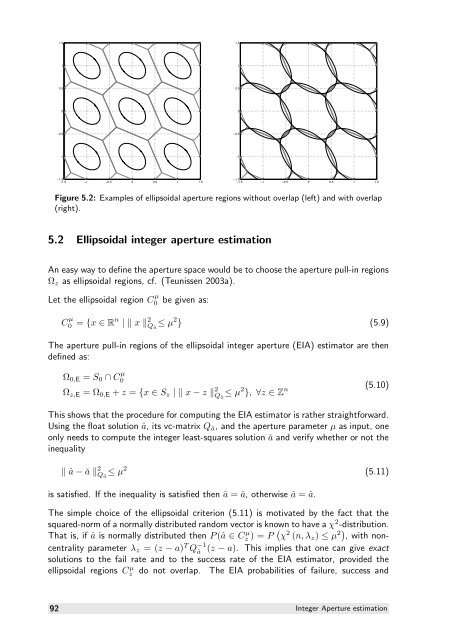The GNSS integer ambiguities: estimation and validation
The GNSS integer ambiguities: estimation and validation
The GNSS integer ambiguities: estimation and validation
You also want an ePaper? Increase the reach of your titles
YUMPU automatically turns print PDFs into web optimized ePapers that Google loves.
1.5<br />
1<br />
0.5<br />
0<br />
−0.5<br />
−1<br />
−1.5<br />
−1.5 −1 −0.5 0 0.5 1 1.5<br />
1.5<br />
1<br />
0.5<br />
0<br />
−0.5<br />
−1<br />
−1.5<br />
−1.5 −1 −0.5 0 0.5 1 1.5<br />
Figure 5.2: Examples of ellipsoidal aperture regions without overlap (left) <strong>and</strong> with overlap<br />
(right).<br />
5.2 Ellipsoidal <strong>integer</strong> aperture <strong>estimation</strong><br />
An easy way to define the aperture space would be to choose the aperture pull-in regions<br />
Ωz as ellipsoidal regions, cf. (Teunissen 2003a).<br />
Let the ellipsoidal region C µ<br />
0<br />
be given as:<br />
C µ<br />
0 = {x ∈ Rn | x 2 Qâ ≤ µ2 } (5.9)<br />
<strong>The</strong> aperture pull-in regions of the ellipsoidal <strong>integer</strong> aperture (EIA) estimator are then<br />
defined as:<br />
Ω0,E = S0 ∩ C µ<br />
0<br />
Ωz,E = Ω0,E + z = {x ∈ Sz | x − z 2 Qâ ≤ µ2 }, ∀z ∈ Z n<br />
(5.10)<br />
This shows that the procedure for computing the EIA estimator is rather straightforward.<br />
Using the float solution â, its vc-matrix Qâ, <strong>and</strong> the aperture parameter µ as input, one<br />
only needs to compute the <strong>integer</strong> least-squares solution ǎ <strong>and</strong> verify whether or not the<br />
inequality<br />
â − ǎ 2 Qâ≤ µ2<br />
is satisfied. If the inequality is satisfied then ā = ǎ, otherwise ā = â.<br />
(5.11)<br />
<strong>The</strong> simple choice of the ellipsoidal criterion (5.11) is motivated by the fact that the<br />
squared-norm of a normally distributed r<strong>and</strong>om vector is known to have a χ2-distribution. That is, if â is normally distributed then P (â ∈ C µ z ) = P χ2 (n, λz) ≤ µ 2 , with non-<br />
centrality parameter λz = (z − a) T Q −1<br />
(z − a). This implies that one can give exact<br />
â<br />
solutions to the fail rate <strong>and</strong> to the success rate of the EIA estimator, provided the<br />
ellipsoidal regions C µ z do not overlap. <strong>The</strong> EIA probabilities of failure, success <strong>and</strong><br />
92 Integer Aperture <strong>estimation</strong>
















